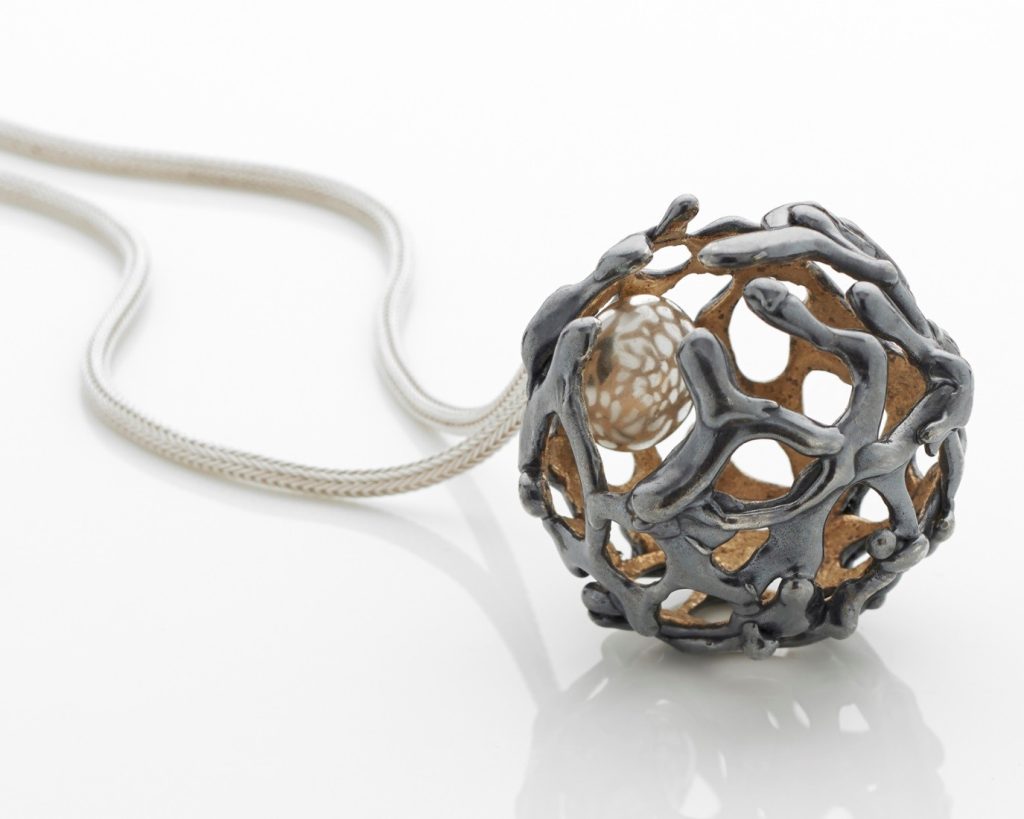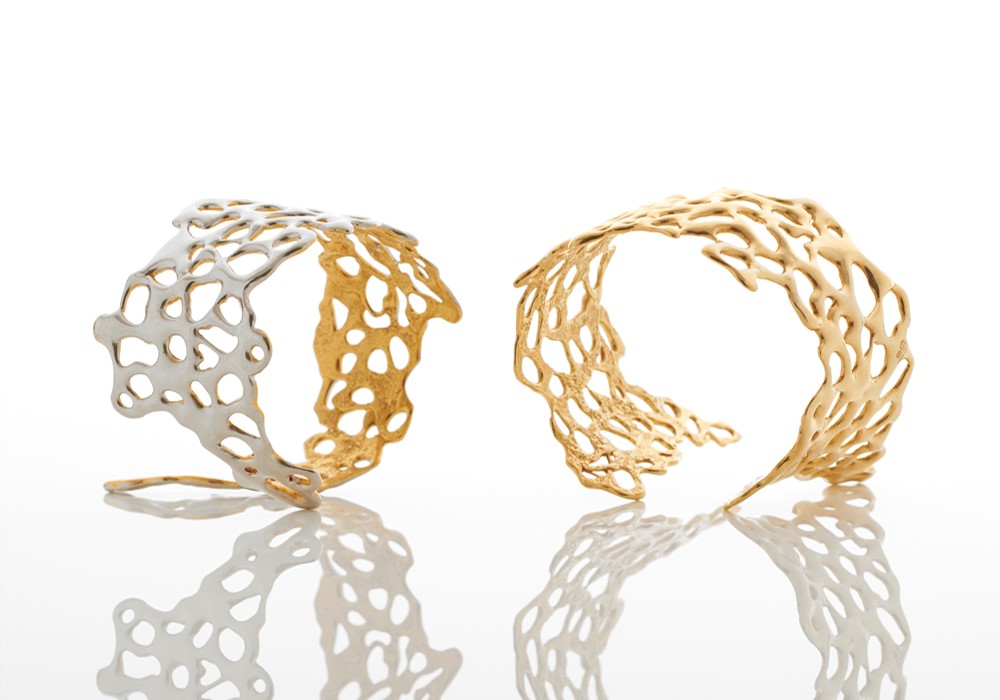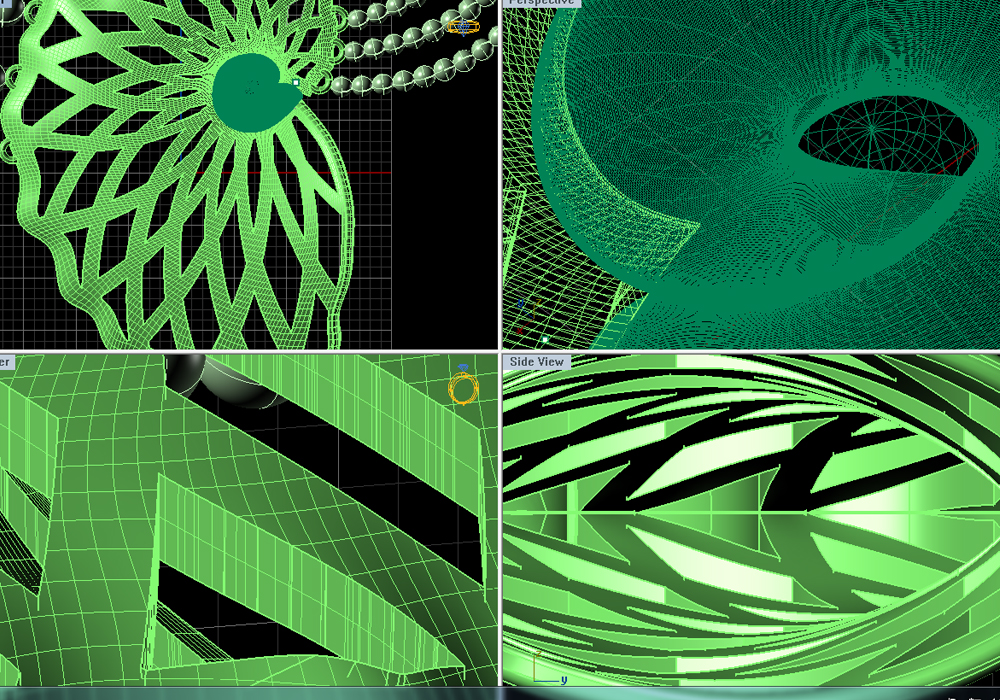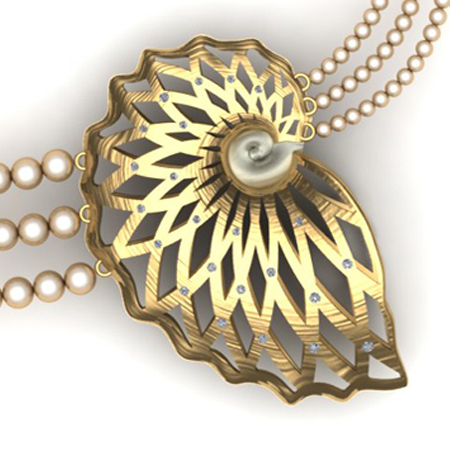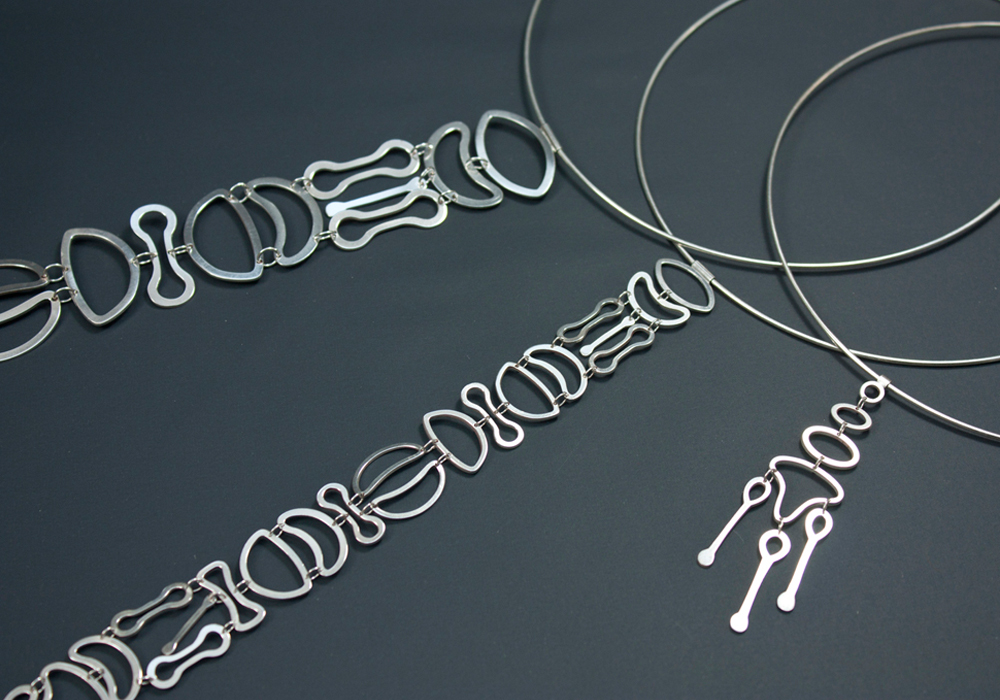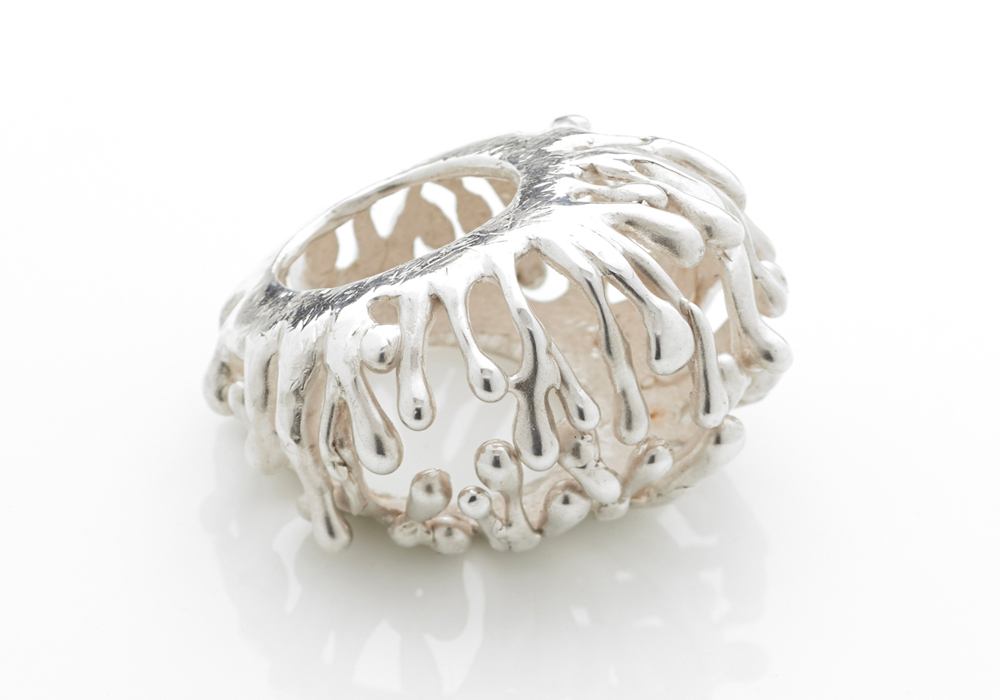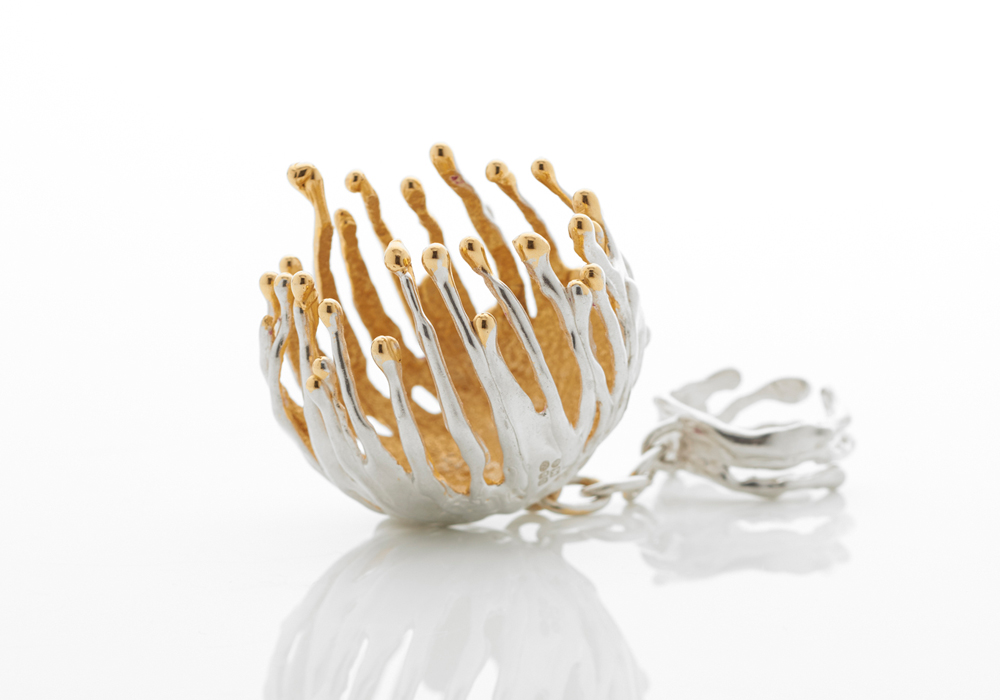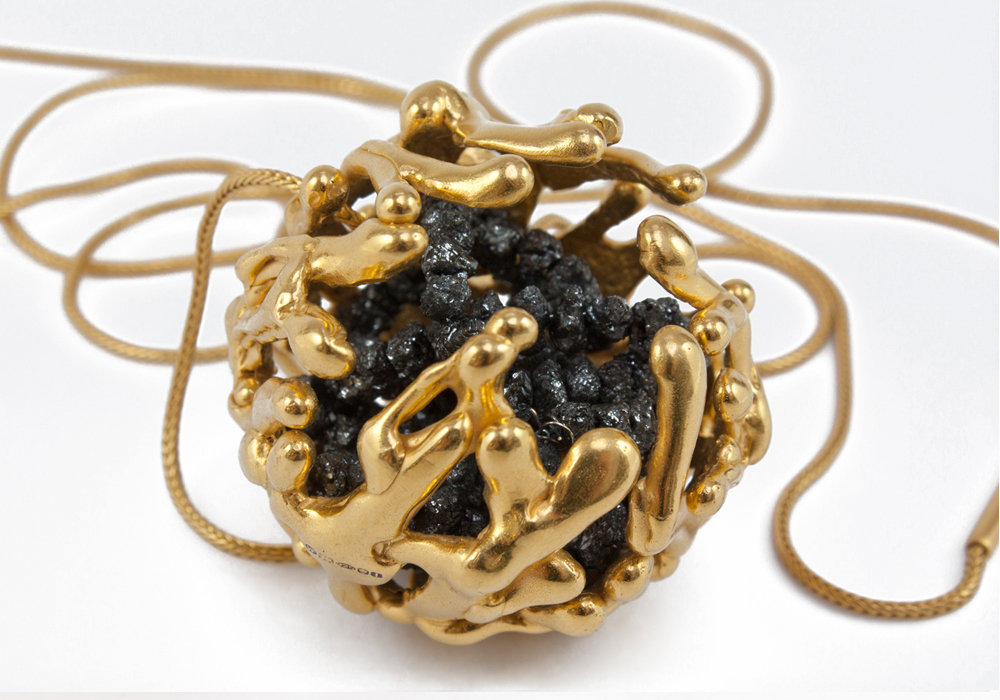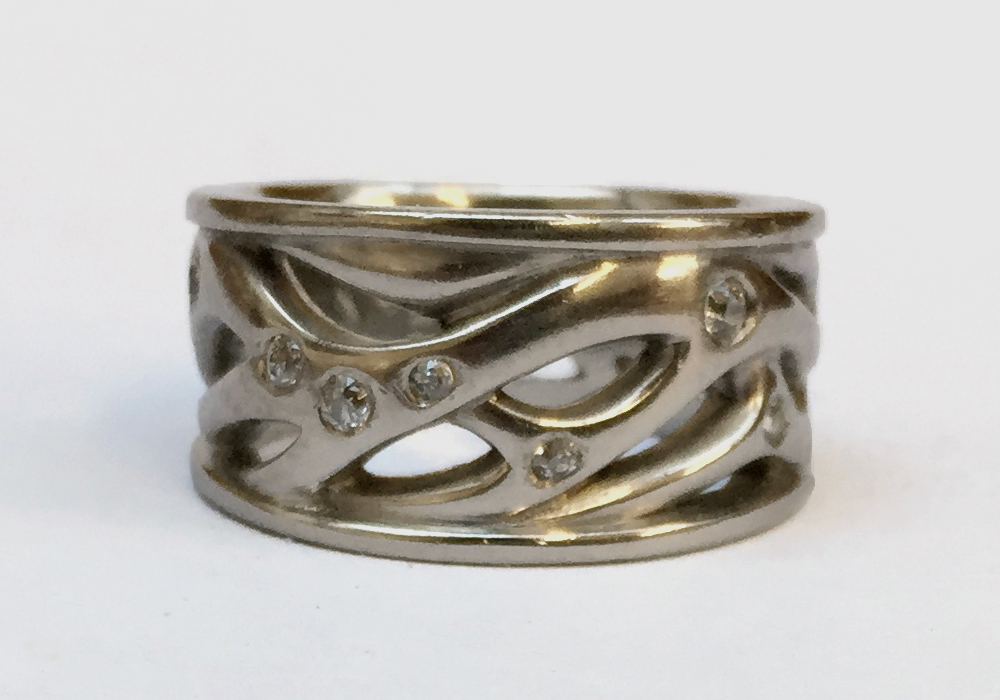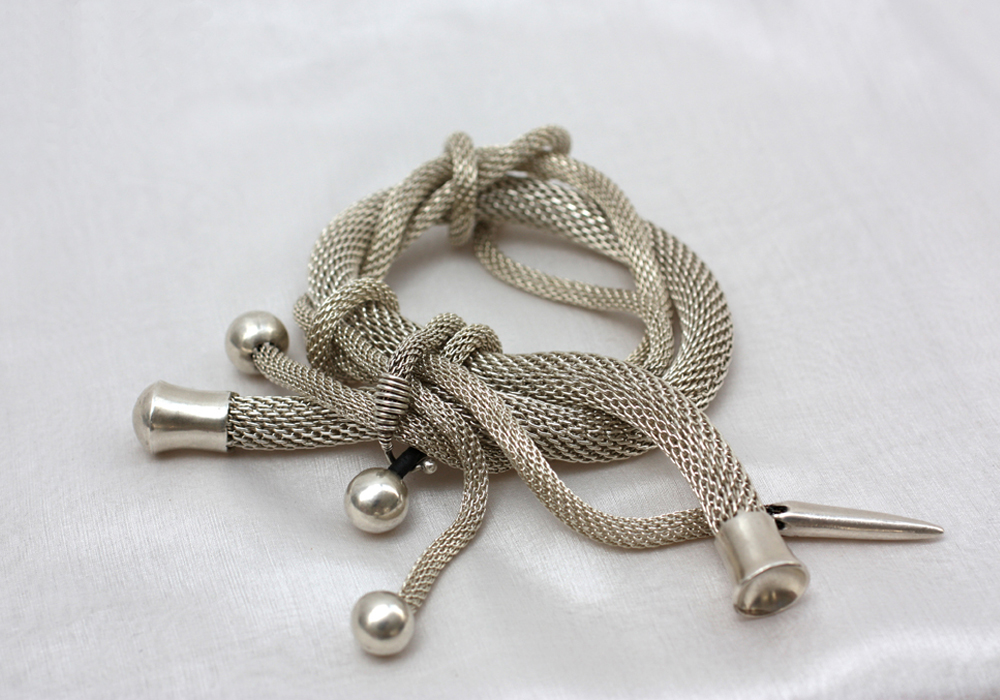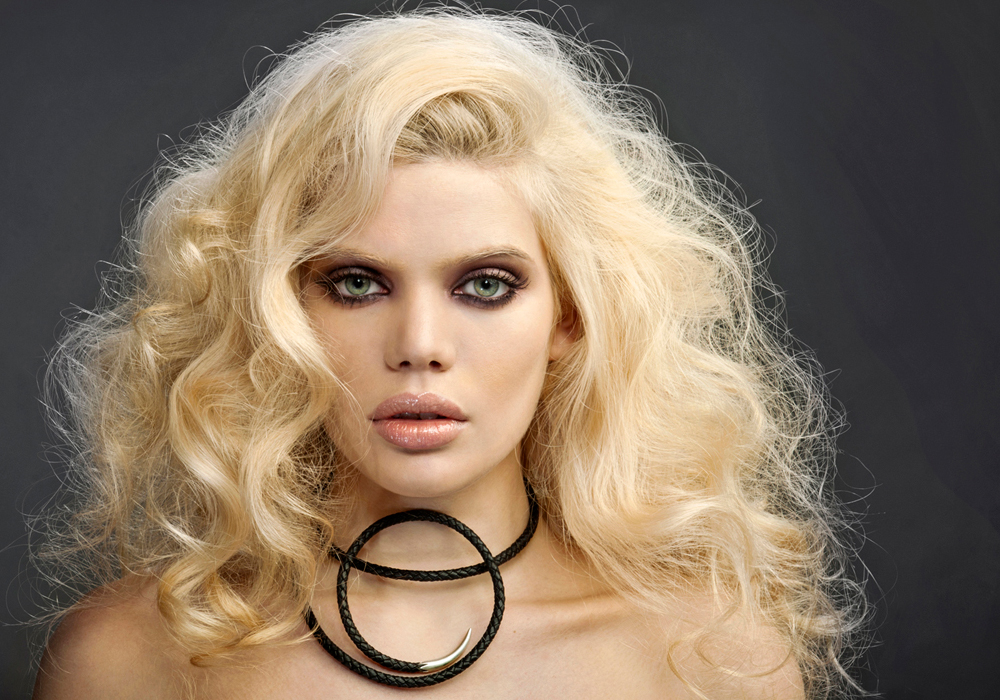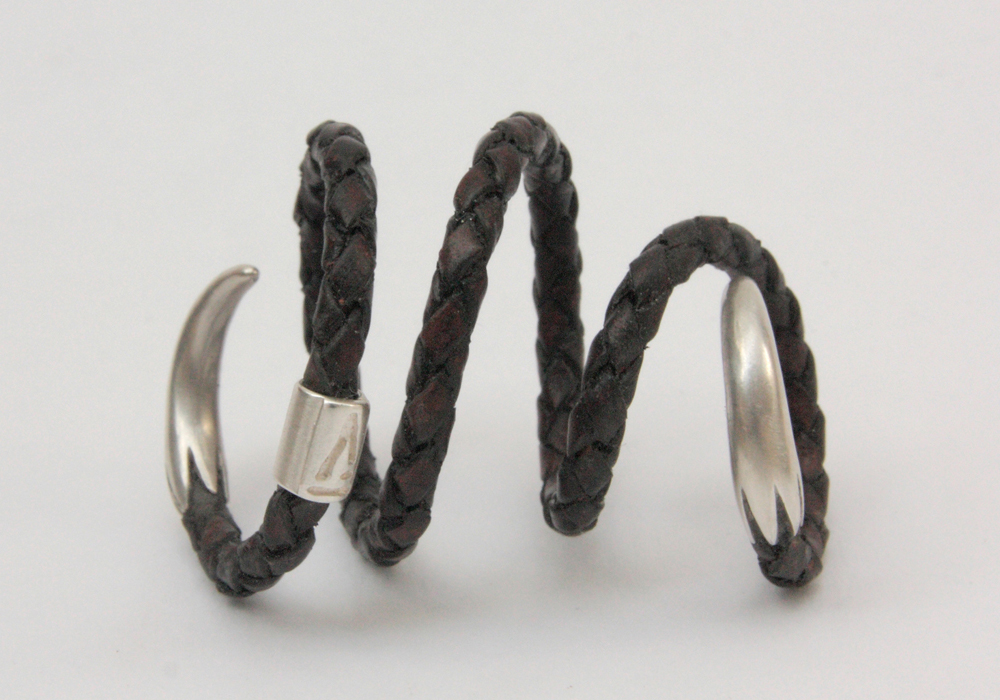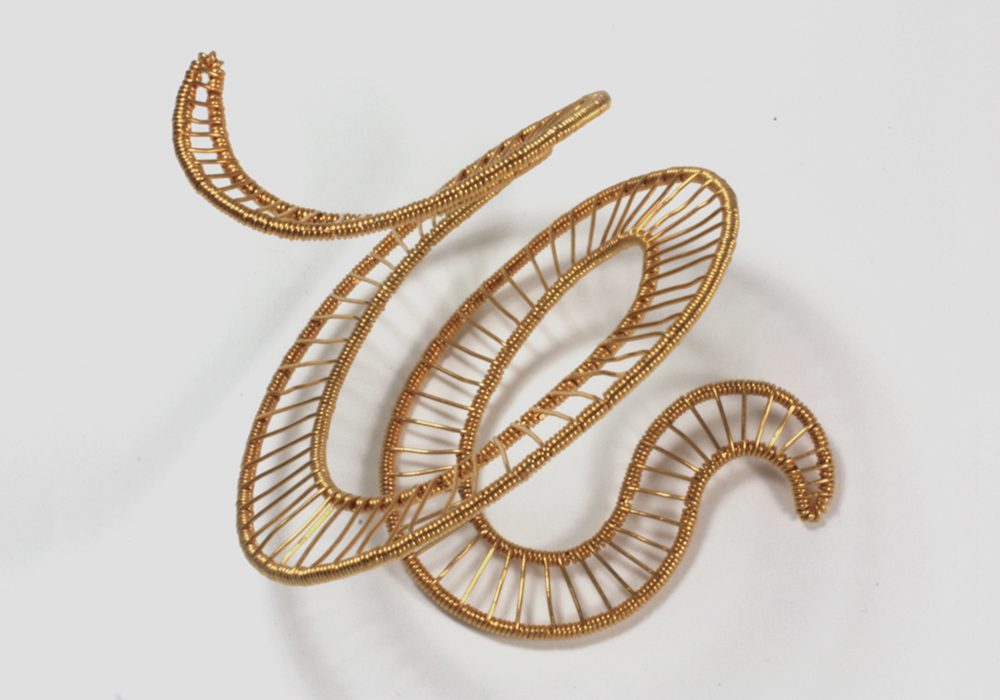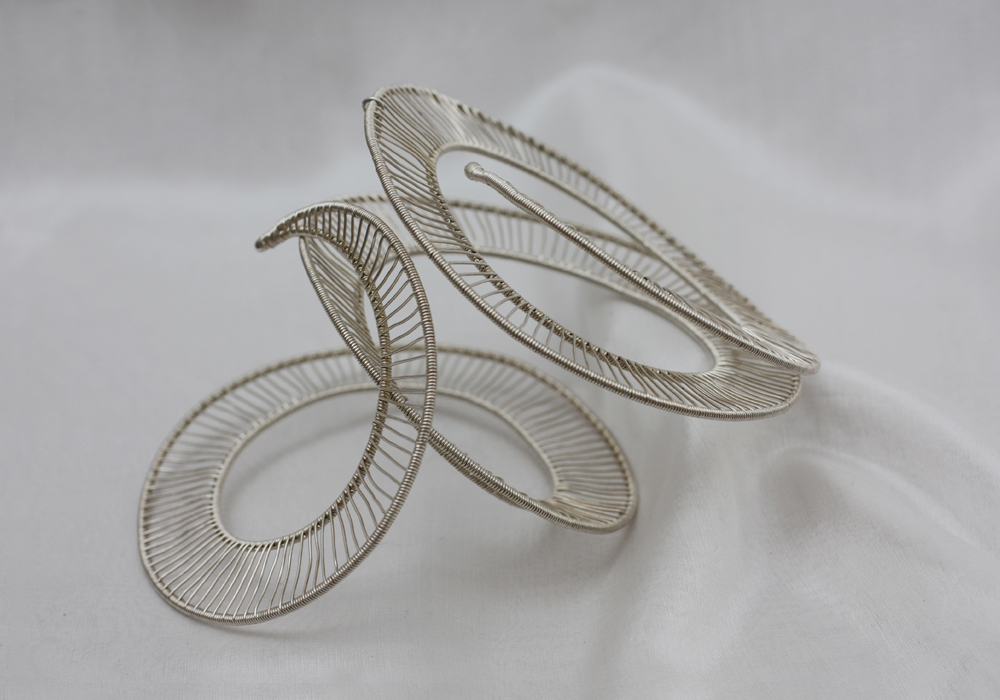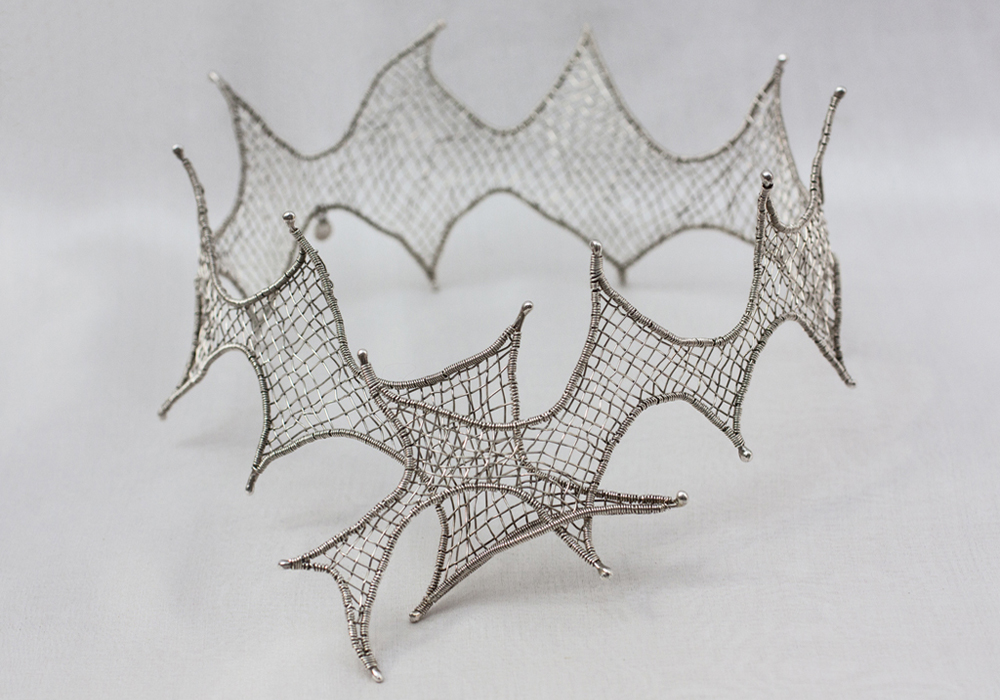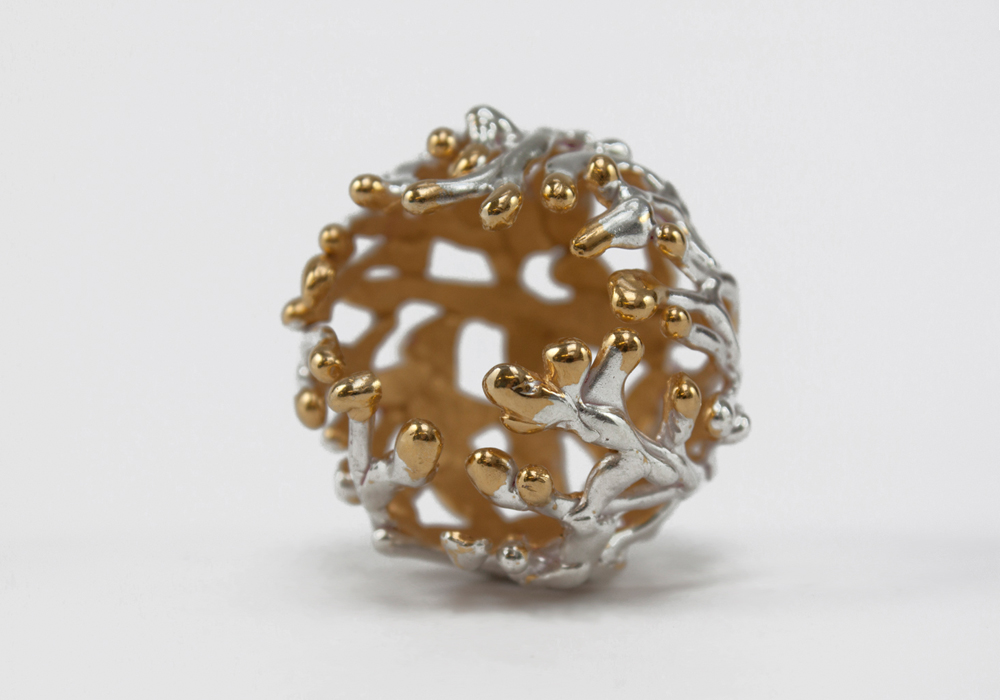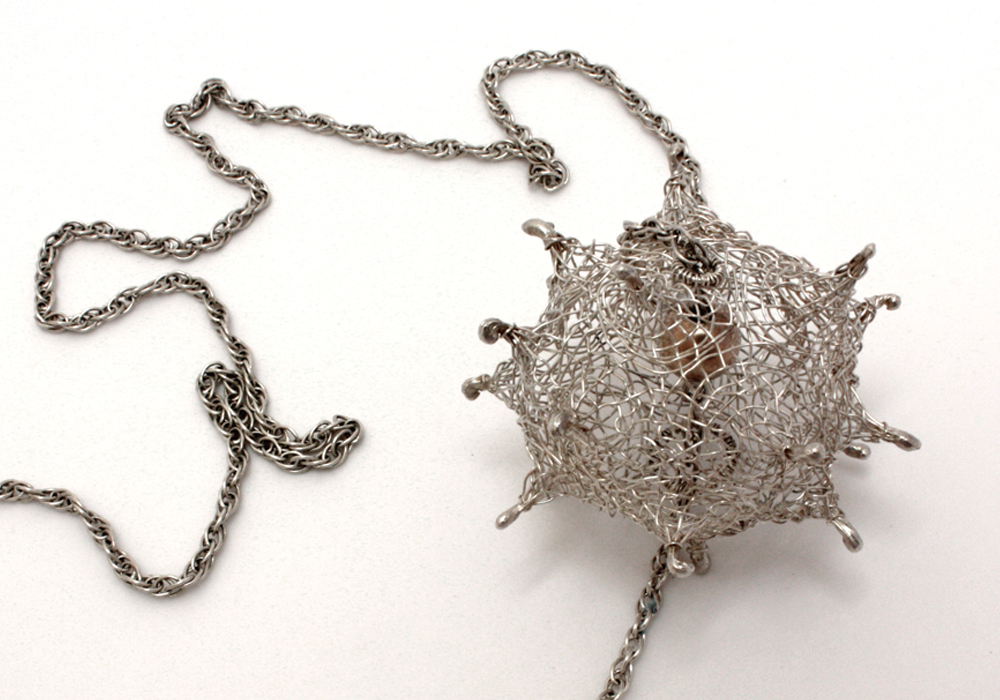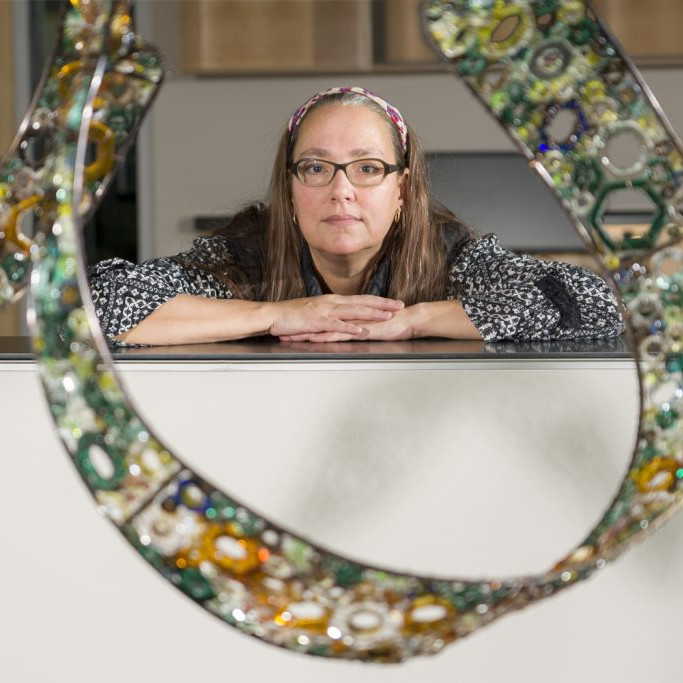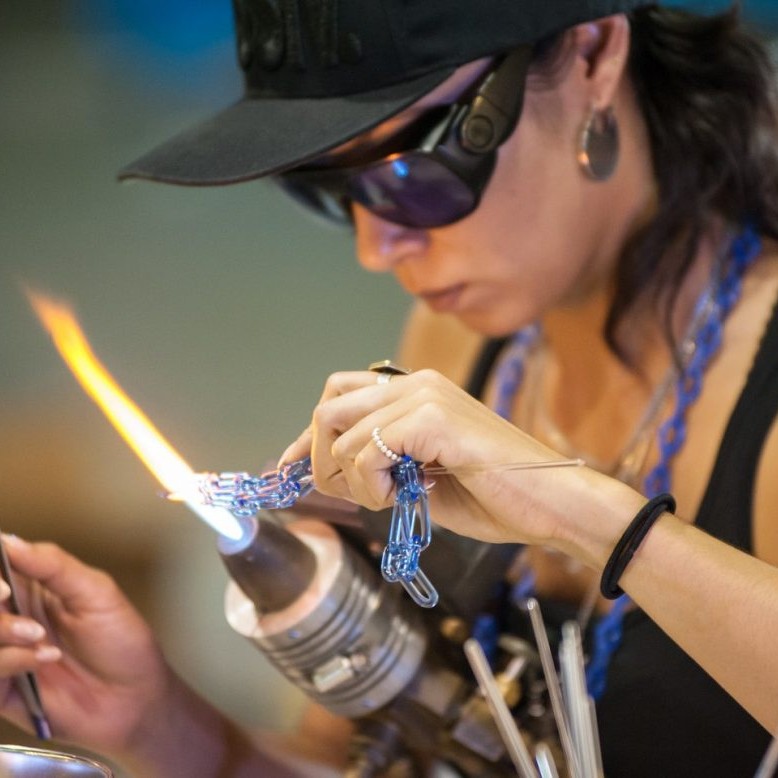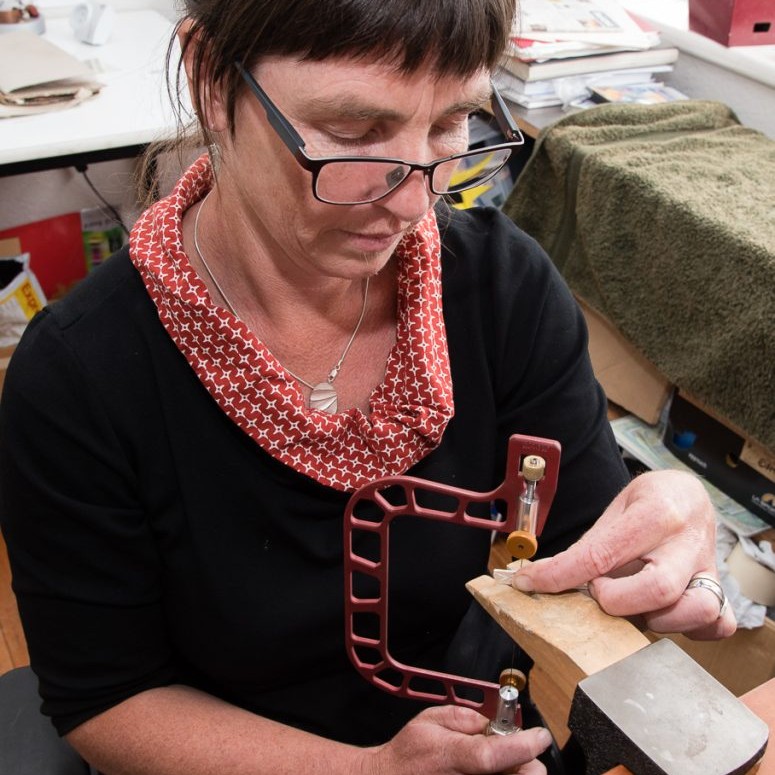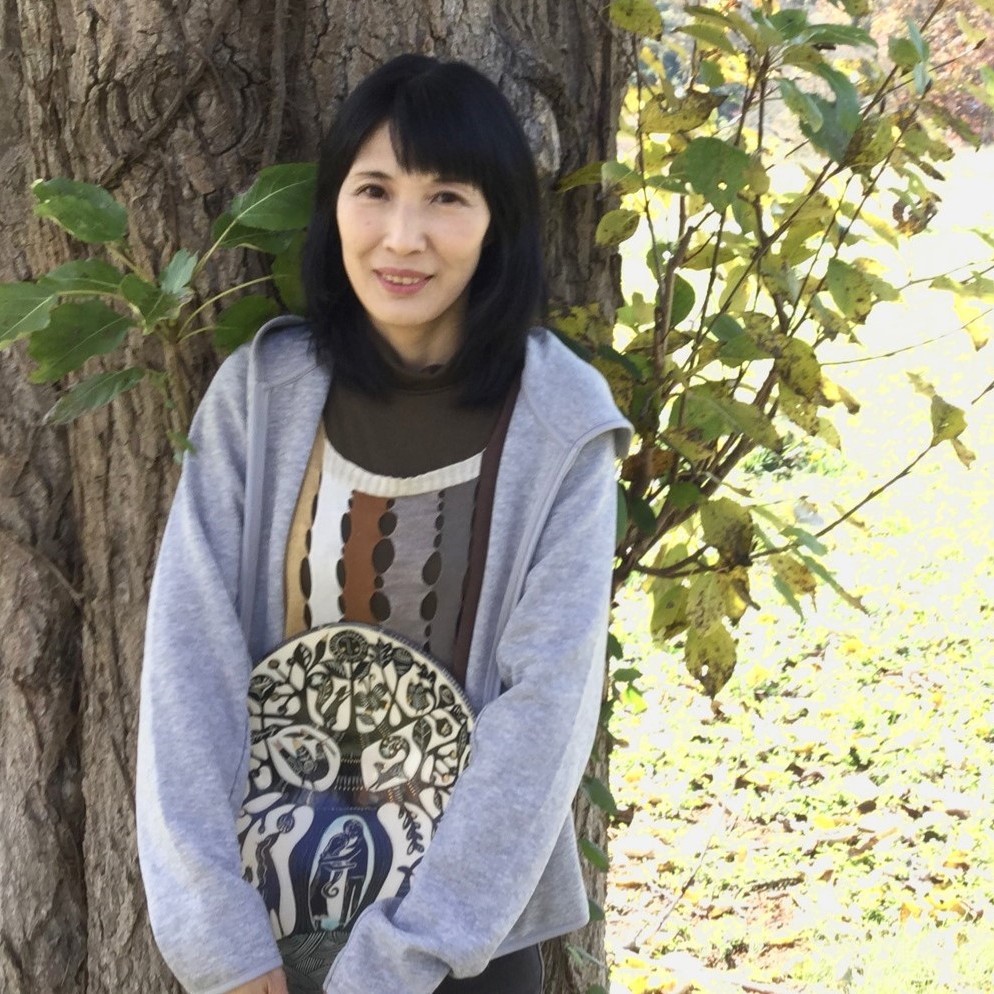Vicky Forrester Jeweller - London, UK
Can you briefly explain the techniques you use to create an original piece from sketch book to completion?
I’m quite playful in my approach to developing new pieces. Sometimes I’m inspired by the behaviour of a particular material, and I look for ways to exploit it. Other times ideas can evolve through extended experimentation with a particular technique.
‘Mystery’
In either case, beneath this process-led practice there is always a conceptual undercurrent that informs the outcome. This undercurrent is a distillation of all my experiences – thoughts, desires, feelings, perception – but especially strong for me is a connection with the elements, and my jewellery always alludes to natural form.
Cuffs
The development of the Siren Neckpiece is a good illustration of my working practice.
It’s a project that came about through taking the challenge to experiment with new technology – Computer Aided Design.
I was curious to explore how CAD might deal with my essentially organic aesthetic. I joined a course to get to grips with the technology, and while I had anticipated I would end up producing a model ready for rapid prototyping – thus the fear of putting the maker’s hands into early retirement – actually I was surprised to realise that my resulting design would be far better made in the workshop using traditional means.
The process itself – designing in Matrix – resulted in my creating a piece of fine jewellery that I wouldn’t otherwise have envisaged and I’m impressed to be able to view and show the piece accurately from every angle through 360˚- before it ever gets made.
I was interested to find that when designing jewellery with CAD you must already have a good knowledge of subject-specific materials and making processes to be able to factor in the quirks of materials and processes eg understanding construction techniques, the impact of scale, and all the tolerances required.
The Siren Neckpiece began with a family day out to Margate. The daytrip provided great inspiration for my CAD Project.
I was interested that the Shell Grotto in Margate has no known beginning though many stories abound. Discovered accidentally in the 1800’s, it became a popular Victorian attraction and the lamps they used to light the underground passageways produced soot that has inhibited the carbon dating process. It has been suggested that the Phoenicians built the grotto 3000 years ago, to worship the Goddess Tanit – hence also the locally named ‘Isle of Thanet’. But perhaps it was a Victorian Folly, or a Pirate’s treasure store – or maybe even a Siren’s haunt!
Using these thoughts, experiences and images as source materials I looked to develop some designs that I could explore using CAD….
I’m pleased with the final outcome; the Siren Neckpiece still maintains some fluidity of the organic approaches I would normally use – it can sit comfortably amongst my existing pieces – and I’m interested to find that through the choice of materials it has tipped me towards a fine-jewellery quality that I have not previously explored.
Expand on the importance of ‘one off’ pieces in your work?
When I explore a technique or material I’m particularly interested to understand how the protocols of that medium can be best exploited to make something that cannot be easily made in another way. So for example, with my growing understanding of CAD, now I see that it is less interesting if used to design an object that might be equally well carved in wax; it’s pretty cool as a rendering tool for showing a 3D experience of your intended design, but it gets really exciting when you develop very complex 3D designs to output using the ‘sintering’ process, where a laser passes through gold dust to make solid your dreams!
So, in relation to my preference for making one-off pieces of jewellery (and small batch production runs), my mind is always working in this way, seeking out new and better ways to exploit the chosen medium and technique, to more precisely express my intentions. Thus each piece I work on is an evolution of the last. For me this interaction is important. It runs counter to the tide of popular jewellery/craft/design culture that now encourages ‘production’ with a more/cheaper/faster approach. I think my clients enjoy that the pieces I make for them are unique.
It also requires an element of trust from my clients. If you see a coral ring that you like on my website, I can make one for you. It can be similar, but not the same, because I must sculpt it in your size in wax before casting it in your chosen metal. I will need to interact with you; you can guide me towards a preferred characteristic and I can put love into the making of it because its materialisation is not some hands-off series of standardised processes that get us from A to Z. It will inherently carry with it the accumulated knowledge and experience of every coral ring I have made before it. It will also be an expression of the maker thinking about you. It will be uniquely yours.
‘Totem’
I find an interesting challenge in the use of technology where it’s inherent nature leads to multiple production. I’m not averse to exploiting this character to further explore a theme – as with my Totem collection.
In this instance, the concept evolved from thoughts of the body, our bone structure and movement. Early pieces were an expression of this articulation; a long column of links became an external vision of the spine; conversely pulled straight by gravity the column causes an exaggerated view of the body’s movements. Each of these links was made by hand and so it was a slow process to develop the concept. Laser cutting provided a means to create multiple units that I could then use to explore new assemblages, hence ideas were able to evolve faster, and in new ways.
You gained your BA Hons. In silver smithing in 1990 what stands out now, 14 years later that you wish you had either learnt or appreciated earlier?
My years at college gave me the freedom to lose and find myself; In discovering that there are no rules to the creative process my ideas became free and flowing, but I think perhaps I was prone to taking life a little too seriously. I hadn’t yet understood that I was allowed to play, and I could have spent more time just doing rather than thinking about it. I came across a quote the other day (courtesy of my favourite Yogi tea) that would have served me well at that time: ‘Stop playing serious and seriously play.’
‘Embrace’
You describe your work as Powerful, Precious, Playful can you expand on each in relation to your work?
Jewellery is magic! When worn it becomes a powerful entity that can instantly transform your mood and your energy levels. It’s also a powerful communicator and so much can be expressed through (and read into) in the kind of jewellery you choose to wear.
‘Spirit Ring’
The notion of preciousness goes beyond material; it describes the relationship we have with our jewellery. Jewellery becomes precious only when we choose to engage with it and for me it’s about it’s history intertwined with your own story. It’s such a personal experience.
I love that it has this ability to transform the wearer and in my jewellery designs I like to exploit this element of play. I seek ways to create versatility in my pieces so that my audience will find numerous ways to wear and enjoy them.
Explain about your ‘Mark’ on your jewellery?
Design
Seeded in nature – the world that engaged me through childhood – my curiosity has always found creative expression through physical form. The tactile and physical elements hold equal importance to the visual. My ‘mark’ is an articulation of the ‘now’ – my current perspective formed as consequence of all accumulated thoughts and feelings – in relation to those ‘natural’, “tactile’ and ‘physical’ undercurrents. Because the creative process is a narrative of my experience (thoughts and feelings, fantasies, realities, my joyous moments in life) this affords me freedom to explore simple and complex ideas, to make drama, all-show pieces, and quiet, powerful pieces too. Over 30 years this has lead to the emergence of 6 distinct collections, each one answering to a particular intention, mood or desire. Distinct and yet distinctly related, I continue to develop new work for the collections as I am drawn to explore these same themes from ever evolving perspectives.
Importance and the meaning of the Mark on jewellery?
A walk through any museum will show you the importance of jewellery in deciphering our history, back to the most ancient of times. Materials, techniques, concepts – all record the evolution of our species, since the beginning of our time. Humankind has always held it precious, hence it survives as a record keeper of our stories, our values, our relationships, how we lived, where we died. It’s an unparalleled communicator. This most ancient of art forms continues to fullfil our primitive urge to express, empower, protect.
‘Joy’
With this perspective then, as makers of jewellery we have the capacity to engage with humanity on many profound levels. Through our personal mark we are in a position to add our unique voice to this conversation. Fired with the maker’s intentions, our jewellery becomes invested with palpable energy, meaning and value that can carry information far into the future.
Where do you go for your inspiration?
Actually I think all my daily experiences, even the most mundane, seem to find ways to influence my ideas; I’m not sure it’s possible (or desirable) to turn off the creative or curious mind, once engaged?
But my ultimate battery-charging, spirit-lifting, soul-feeding place to go is the seaside. I have strong family connections with the south west coast of Ireland and west coast of Scotland and most of my formative years were spent in one place or the other. The tides, like a breath, wash the city grit from between my ears. In, out, to the end of time. Scrambling across incredible rock formations to find rock pools teaming with jewel-like life-forms; palm trees and gorse beside golden sandy beaches, crystal clear waters, wind in my face, pockets full of stones…. Up from the shore, the damp-sweet smell of bog myrtle and bracken, raspberry picking along the hedgerows…home to family. Happy days!
My camera is an all-the-time essential tool that I use to capture, record and document the interesting moments in life. Before the camera, experiences were committed to memory, and I visit them frequently when my eyes close. Now they’re all on my phone-camera. I hope it’s not making me lazy.
Tell us one or two special story / stories of a piece you have made on commission?
I love the collaborative challenges of working to commission; It begins with a jumble of fragments, and between us the client and the maker must conjure them into dazzling solid form.
Usually the client brings an ephemeral element – a wish, a passion, a story. Often there is a physical element – a precious stone, an unwearable inheritance, a preference for material. The third element is the maker’s aesthetic. All of these ingredients must be drawn together, mindfully working with the material, it’s behaviours and the processes required to transform it. Metal is an endlessly forgiving material to work with; it yields sonorously to the hammer, can be pushed, scraped, filed and polished into form, or entirely transmuted through fire to a new vision of beauty. I like that the process often begins with recycling. A broken chain, an heirloom ring, all are given a chance to become something new, to live with relevance!
Here is a constant reminder of the transient nature of all things. I hope that my creations will be enjoyed and treasured, that they will be lovingly passed from one person to another with an endlessly expanding story. However I must accept that one day a new owner may give more value to the metal than to the form I have given it. The narrative of its changing form may be carried on through generations, and perhaps also at a molecular level there remains an ionically- bonded memory between the metal and it’s long history!
‘Flowing Ring’
Flowing Ring, recycled from the client’s unwanted 18ct white gold jewellery. The old rose-cut diamonds, also inherited, came from a beautiful and dazzling tiara that had no place to shine in these modern times.
Discuss your Medusa Range?
Inspiration
The first pieces I made in this collection were inspired by ‘material’ – I loved how this fabulous chain coiled and twisted, and I looked for ways to exploit this behaviour.
‘Rattlesnake’
Subsequently I came across this woven leather cord and it provided a means to create more structured forms that could defy gravity or wrap the body. By adding sterling silver elements to my structures this gives sharp contrast to the soft appearance of the leather, meanwhile also suggesting latent power, perhaps a little dangerousness to the resulting pieces.
The name ‘Medusa’ derives from ‘metis’, or sovereign female wisdom. I chose this name for the collection because I found these pieces seductive, and hypnotic. As the collection grew I sought to understand this primal connection. Unlike the image portrayed of Medusa, I felt empowered by my snake-like forms, and so I sought out her deeper secrets… The story of Medusa as told in Greek Mythology is a neat exercise in the subjugation of female power, and her story, pertinent as ever, echoes through the centuries and through every culture. A woman is ravished because she is too beautiful to resist; on discovery, she is blamed for her beauty. She is cast out as temptress who must be punished and she is eventually slayed. In naming this body of work ‘Medusa” I look beyond the traditional mythology of the snake-haired, petrifying gorgon to reclaim her roots as Snake Goddess, who’s beauty is her soul. Powerful she, who holds in her hands the timeless cycle of life.
On photography
Photo by Rowan Papier
When I photograph my work I tend to take quite neutral shots that try to show the sculptural element of the pieces. Sometimes, as with this collection, this isn’t enough. These works needed to be seen in context, and I gave the photographer free reign to portray the Medusa collection as he felt inspired. I love this raw, charged imagery that he produced. The model, his muse, has an intense energy that draws parallels with Barbarella and the feminist view of Medusa (female rage) all at once.
Dressing up or Dressing down
Of course, not everyone who wears the Medusa Neck wrap chooses to make this, along with well-drawn smoky eyes, their only item of attire!
The playful element is an important aspect of this collection, and each piece can be worn in as many ways as you want to try them. The medusa ring can be worn as one coil on the thumb, or twisted to coil across 2 fingers for a more dramatic look. Or perhaps you need a little something to hold your scarf in place. I twist these Medusa pieces into my loose-knit jumpers too.
Discuss in more detail ‘Medusa Arm Wrap’
The Medusa Arm wrap has a similar versatility; Stretched out the piece of leather is almost a meter in length, so the multiple coils can be used to give three-dimensional structure, or to coil around any part of the body.
Discuss Helix and the inspiration of this work?
The Athene collection also explores how coils can be used to create structure. In this instance the collection was seeded from exploring ‘process’. Using binding techniques I wanted to create forms in silver that would be light and structured, that would also respond well to the body’s movement. Spirals and tendrils seemed to be a natural outcome to the slow process of binding, (hence Helix) and through experimentation I began to understand how the desired three dimensionality of form could be dictated by working around a shaped, internal framework.
I chose the name for this collection because Athena was known as both warrior and weaver. The pieces evolve through a similar repetitive process, creating structure and dimension from threads, and the final outcomes seem to me fierce and proud.
‘Athena’
Your piece the ‘Venus Rose’ has been designed to be worn in different ways. Discuss the importance of the versatility of piece.
It’s actually quite some challenge we jewellers face to make an item of jewellery that absolutely anyone can wear. Before we even touch on style and preference for a ring, necklace or cuff we must pay attention to the dimensions of wearer. ‘Average’ measurements, as with fashion, are never accurate enough for a well fitting neckpiece, and so in the Venus Rose I wanted to explore ways to make it so that could fit anyone.
‘Venes Rose’ (desire)
The solution I found was to weave the thorny form in one long length, thus creating a wrap that can interlock at any chosen point. In the process the piece becomes ever more versatile so it can be worn high as a choker or loose, more like a collar, depending on the clothes you want to wear with it. And of course being a single length of woven material, it can be used to wrap around any part of the body!
How do you think jewellery should be documented by the owner?
Jewellery should be purchased for wear, should be worn and enjoyed, and passed on with love. I like that jewellery is held most precious for the story it carries; certainly it grows richer, gathering a new kind of energy as it lives through the experiences of the wearer(s).
My Great Aunt left little notes in the boxes of the jewels she felt to be precious; other items held their value in Chinese whispers, though time (and the internet) often revealed another story, certainly in the case of the treasured Lake Como pearls that in years proved flaky and faux. Perhaps she had meant: ‘from the pearl of Lake Como’ and not ‘pearls from Lake Como’ as we had understood it!
What details should be recorded for future generations or owners?
Of course, the hallmark tells a small part of your jewellery’s story – the maker, the date, the place of making, the type and quality of metal it’s made from. The living history – myth and fact interwoven – holds the greatest room for mystery, intrigue, delight. Where does your mind go at the mention of Kohinoor? Passing on the stories behind a piece of jewellery will always have the greatest relevance. Queen Victoria had the Kohinoor’s original rugged beauty cut and polished into her vision of beauty. Only the ‘now’ owner knows the true value of their jewellery regardless of the perceived material or historical value. Ultimately if they don’t like it, if the story feels irrelevant, they may have it melted, just as so many of my clients’ commissions have begun, to be re-fashioned into something with greater personal resonance. This leads me to embrace the ephemeral nature of all things; everything worldly is a constantly shifting arrangement of the same atoms and molecules. As a jeweller, I am pleased if somebody can enjoy my various atomic arrangements. But it’s only ‘now’ matter. Tomorrow it could be transformed into someone else’s dream.
What lead you to opening Flux Studios?
My own journey into becoming (and surviving as) a jeweller gave me insights into the challenges and pitfalls that you must face when first setting out as a maker. It’s not an easy commitment to make, and I applaud anyone who makes that tough decision to follow their creative path.
I’m a big advocate for adult and community education, especially in the creative field; it provided me with a route into finding my passion for jewellery, and I know first hand the many benefits that result, on a personal, social and communitywide basis. For this reason I have always held the teaching element of my working practice as a vitally important link in my creative activities. In 2008 I decided to take a leap, to leave a part time teaching post and to use the redundancy money to set up a studio where I could marry these two major influences together. My aim was to produce my own work, and to provide a fully equipped working environment where other jewellers could develop their practice in a supported, mentored, community environment, and where I could continue to offer classes and courses in jewellery for the local community.
‘Peace’
Flux has proven to be a very successful model, and there’s a real sense of community here that has taken on it’s own inspirational dynamic; although the business is fundamentally mine I describe the activities and achievements here in terms of ‘We’ and ‘Our’ because without the willing participation and generous contributions of the people who use Flux Studios, it could not exist.
How does Flux operate?
Flux Studios is a specialist jewellery studio and jewellery school combined. Our remit is a simple one – to provide a platform where expertise, enthusiasm and the open exchange of ideas combine to inspire creative genius! In practical terms this means:- We provide opportunities for people to explore and expand their creative potential using jewellery as a medium, through jewellery classes, courses and workshops. We provide a dynamic studio base for aspiring jewellers to explore their business potential and achieve success, offering a fully equipped jewellery workshop, extensive library, mentoring and support network, learning and teaching opportunities as well as exhibitions and promotion – all through our membership scheme. We achieve a unique dynamism in the Studios by integrating classes and workshops in jewellery-making alongside professional jewellers who are carrying out their activities to develop their business. In this way students are inspired to develop better skills, and the professionals develop their communication skills and gain feedback on their work as it evolves. Audiences are developed and skills and knowledge shared.
Combining a teaching environment with a professional working studio Flux has a skills pool that makes the whole far greater than the sum of its parts. Because we are small we can focus on the unique individual need, inspiring people to achieve excellence. In providing a home to both aspiring professionals and the interested public we have evolved a holistic creative studio environment where the individual skill sets of all our users are valued and shared to enrich this community as a whole.
Discuss, membership to Flux?
Anyone with a passion for making jewellery, and the skills and training to work autonomously and safely in the workshop, can apply to join. Flux membership acts as a proving ground for future jewellers; in sharing expertise the group has the potential to be greater than the sum of its parts and ultimately this improves the probability for each member to create successful businesses and enriching careers in jewellery.
Flux members have access to our exceptional facilities, mentoring, exhibition opportunities, skills development, teaching opportunities, community interaction and audience building, and our network of Flux Alumni that now spans the globe, all for a nominal monthly fee. When a new member joins at Flux I encourage them to feel a sense of equality and ownership within the studio, right from the start; this gives members autonomy in (and respect for) the space and this instils real confidence to grow, share and learn.
This also makes it a great place to work!
Have you thought of E coursed for those of us who don’t live in London?
Ah, if only there were more hours in the day, more days in the week! But in the meantime I can recommend a great book…
Elemental Jewellery by Vicky Forrester
ISBN 9780956438270
£18.99, from all the best book stores.
Or order your signed copy direct fro the Author
Contact details.
Vicky Forrester, London, UK
Interview by Deborah Blakeley, April, 2015
Think a colleague or friend could benefit from this interview?
Knowledge is one of the biggest assets in any business. So why not forward this on to your friends and colleagues so they too can start taking advantage of the insightful information the artist has given?
Other artists you may be interested in:



